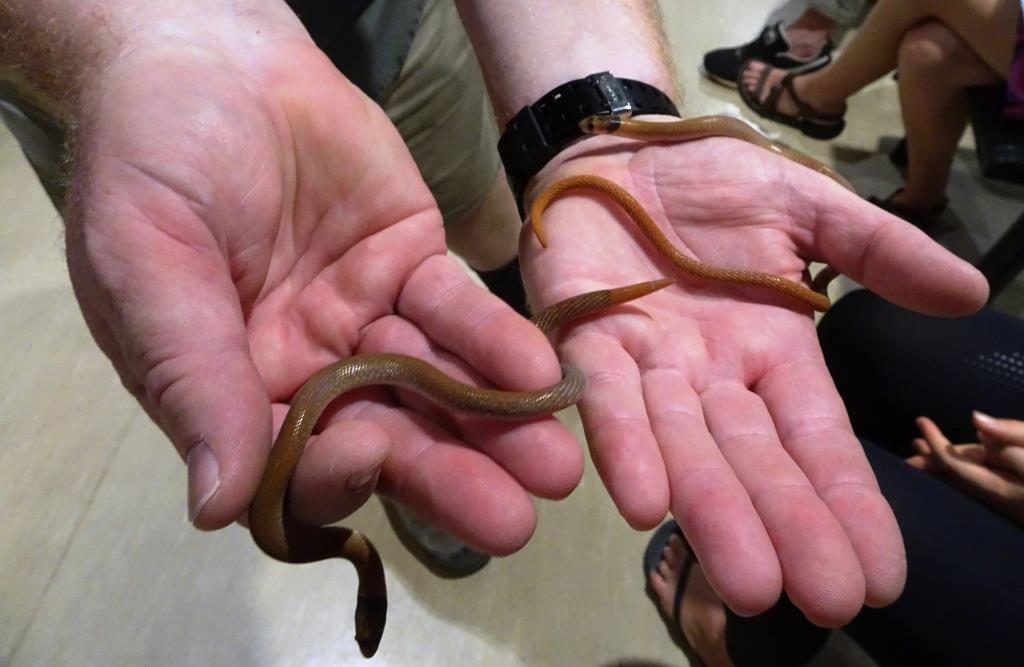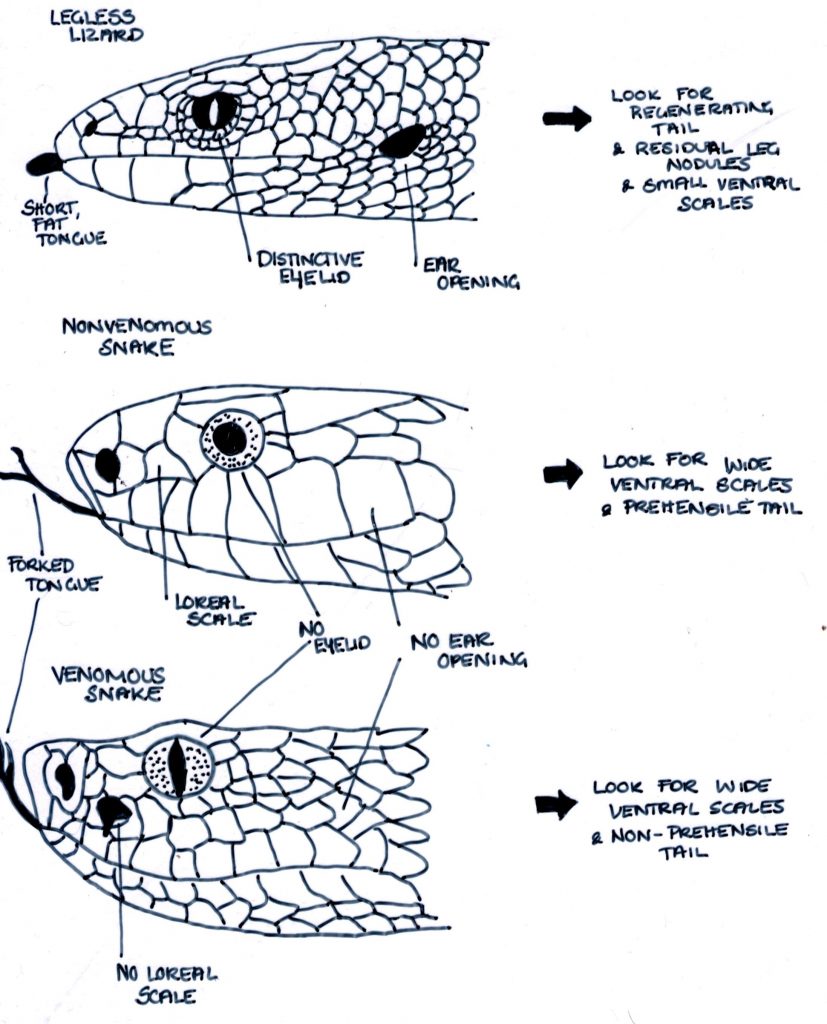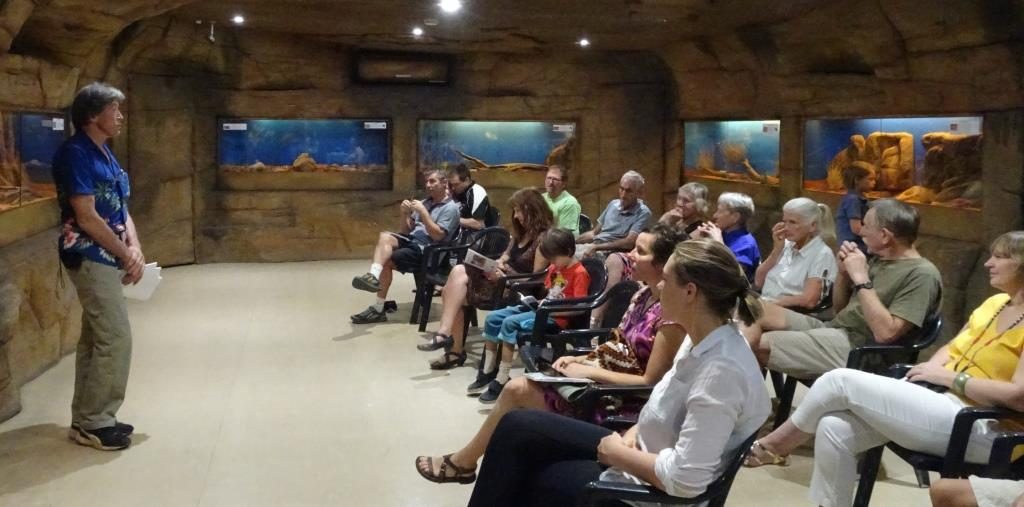Land for Wildlife launched the second edition of Reptiles and Frogs of Alice Springs by Nic Gambold and Deborah Metters at the Alice Springs Reptile Centre this month. The launch was attended by 20 keen Land for Wildlife and Garden for Wildlife members, who were treated to a presentation by Rex Neindorf on the biology and habits of legless lizards (Family PYGOPODIDAE).
Rex explained how members can identify the differences between some of the common legless lizards and small venomous snakes. He showed an example of an Excitable Delma or Excitable Snake Lizard (Delma tincta), which can often be confused with a baby brown snake. The two reptiles have a similar colour, both lay eggs and both slither along the ground. However, there are some clear differences, which were explained in detail and shown to those attending the event.
When the Excitable Delma was released onto the ground, the reason for its name became obvious. The legless lizard launched its body around on the ground with a huge amount of excitement. This was a great way to distinguish the difference between this particular legless lizard and snake. Rule 1: Snakes don’t jump. They do slither along the ground and they can launch their head and front third of their body, but they are not jumpers. Excitable Delmas are able to jump several centimetres off the ground, using their whole body.
Legless lizards have ears and some have eyelids and snakes do not have either. This is an easy way to tell the difference between the two types of reptiles, if you can get close enough without putting yourself or others in danger. Snakes can’t blink, instead they have a thin transparent scale that covers the eye, which are known as spectacles and are replaced when the snake sheds its skin. Snakes don’t have visible ear openings, but rather their inner ear is connected directly to the jawbone, which senses vibrations. Many legless lizards have small ear openings behind the jaw. Legless lizards may have lost their legs as large extensions over evolutionary time, however they do possess small residual nodules to the rear where the hind legs would have been. Keep an eye on the tongue of the reptile when it licks the air. Snakes have a very distinctly forked tongue, which is quite long and slim, whereas legless lizards have a fatter tongue that lacks a defined fork.
Legless lizards have the ability to drop their tail as a life-saving protection mechanism from predators, known as caudal autotomy. Many land owners are tricked this way when they are frightened, thinking they have found a snake and take to the individual with a shovel, only to find the animal does not die (quite the opposite for a snake, but we do not recommend testing this theory as we are pro-life for all reptiles!). Many legless lizards have a very small body and a large tail and hence are not killed when sliced in half. The tail will then regenerate given enough time and cause no discomfort to the individual. The regenerating tail has a slight colour difference in comparison to the rest of the body and so a shearing point can be found on some legless lizards that have undergone regeneration. Snakes do not regenerate a tail and therefore similar patternation can be found down the length of the body.
Some other distinguishing characteristics are less easy to identify in a hurry. For example, if you can get the reptile to roll over (good luck), you can check the ventral pattern of the scales. In venomous snakes, the ventral scales are wide, extending along the width of the belly and continue in such a way down the length of the body. In legless lizards, the scales on the underbelly are much like those on the rest of the body. Snakes are able to use their belly and side scales to move in an S-shape along the ground, whereas legless lizards can only use their sides. This means that if a legless lizard moves onto a completely smooth surface, it will lose its ability to move (important to note if you see one on the road – take care and drive around it if possible). If you happen to keep an eye on it long enough to find it feeding, legless lizards are not able to unlock their jaws to swallow large prey so they will generally go for smaller food items than snakes will.
Differences between venomous and non-venomous snakes include the size of the body scales (large in venomous snakes and small in non-venomous snakes), patterning of the body (non-intricate in venomous snakes and intricate in non-venomous snakes), tail movement (non-prehensile tail in venomous snakes, prehensile in non-venomous snakes) and loreal scales (no loreal scales in venomous snakes, loreal scales in non-venomous snakes).
Rex also explained about the snake catching service provided by the Alice Springs Reptile Centre. He noted that they have caught fewer snakes than usual this year since there has been a lot of rain so the snakes can’t be seen amongst the grass as easily, though the catch levels were still higher than we expected.
If you notice a venomous snake on your property, you can call the Alice Springs Reptile Centre call-out number on 0407 983 276. Keep an eye on the snake and they will attend to collect it as soon as possible. Snakes are then released at several sites around Alice Springs in the rural area, depending on the required habitat of the caught individual.
The Alice Springs Reptile Centre is selling snake bandages that have indicator boxes to determine the correct application of tension to prevent the venom spreading. If you are updating your first aid kit, you may wish to visit Rex and his team to discuss suitable bandage options.
Thanks go to Rex Neindorf for launching the Reptiles and Frogs of Alice Springs booklet and providing such an informative presentation!
The Reptiles and Frogs of Alice Springs booklet can be purchased from Land for Wildlife Central Australia for $15 at any of our upcoming stalls at local events. You can also grab copies from Arid Lands Environment Centre and Red Kangaroo Books.
Categories:
Amphibians, Event, Morphology, Native Fauna, Presentation, Reptiles, Workshop


